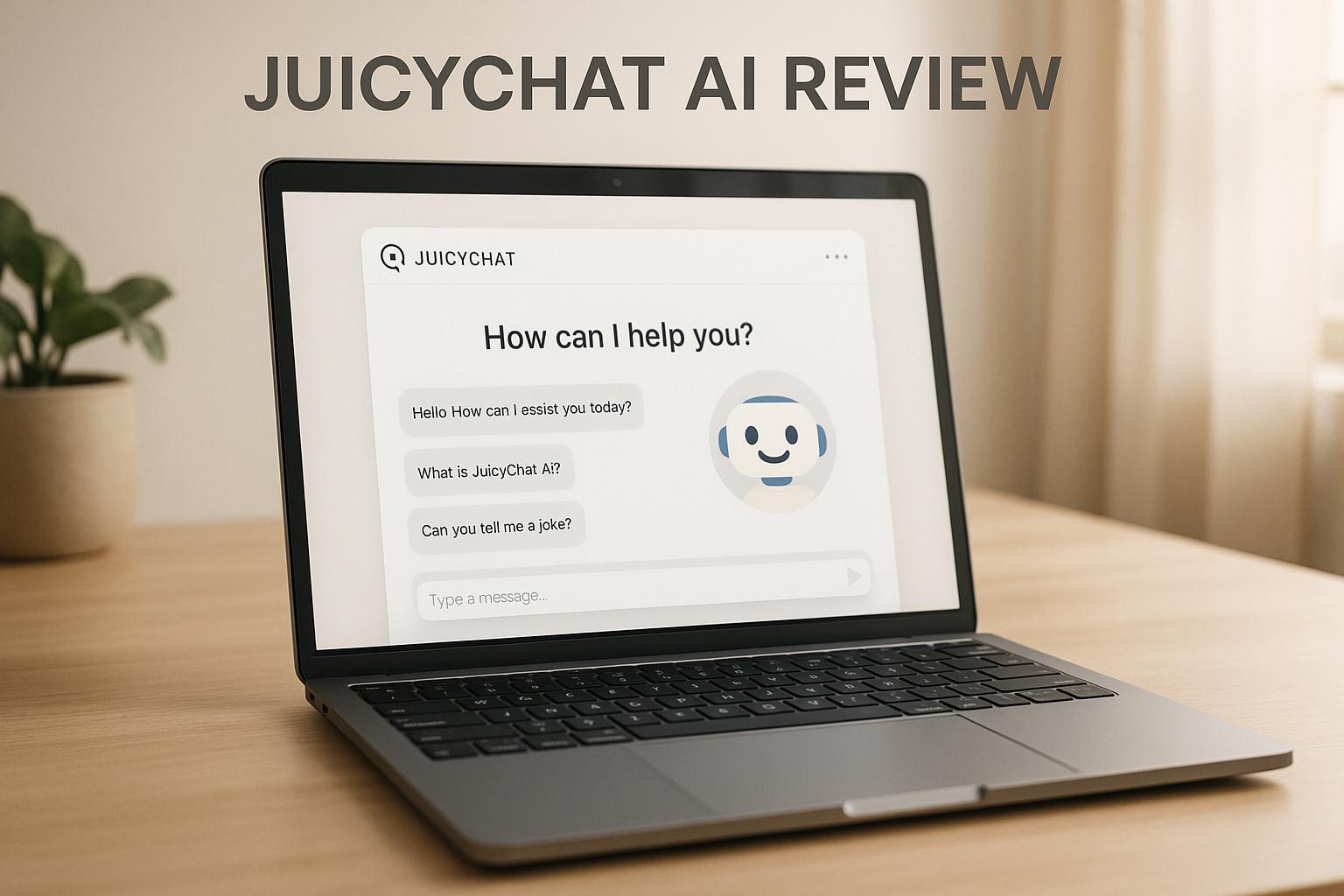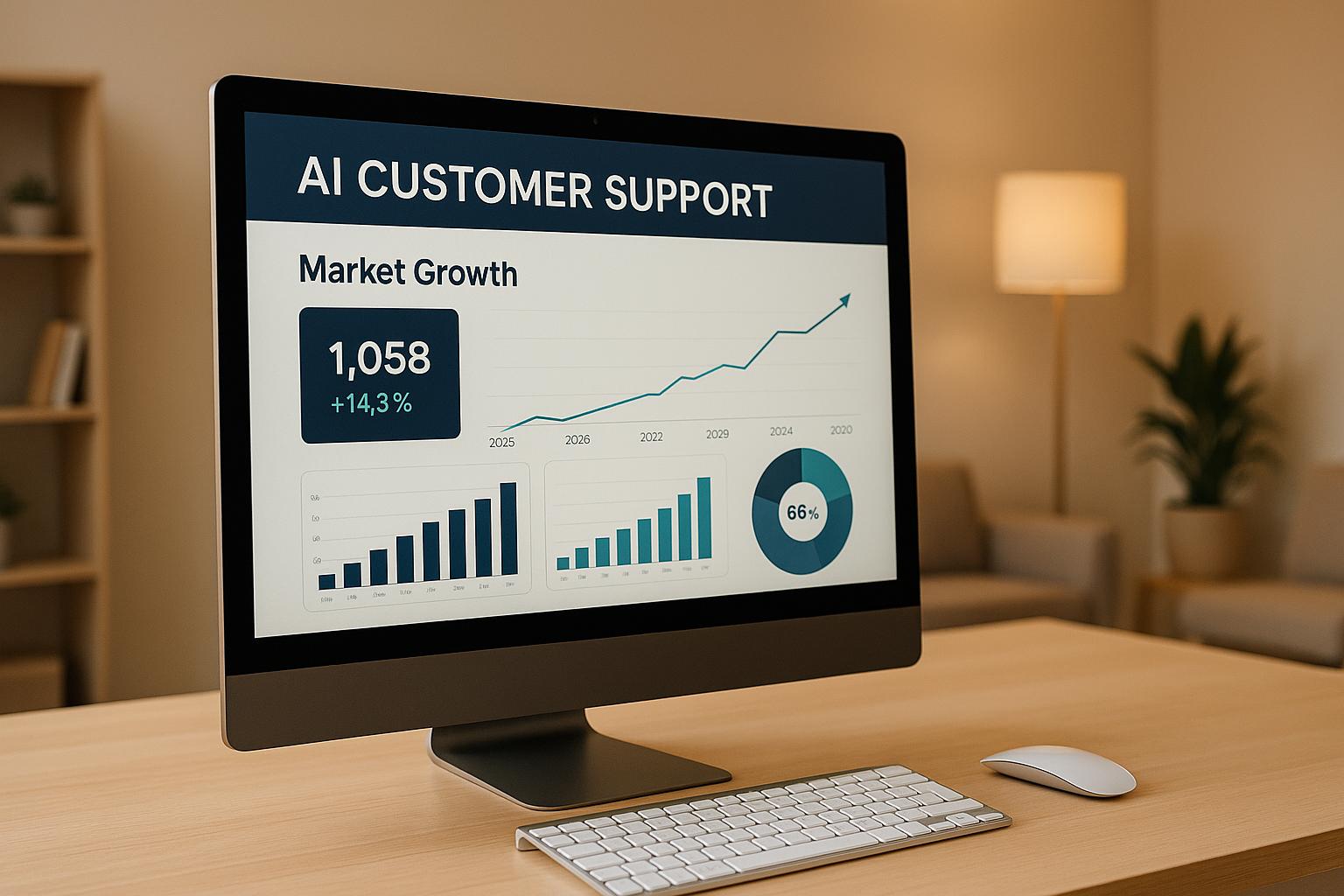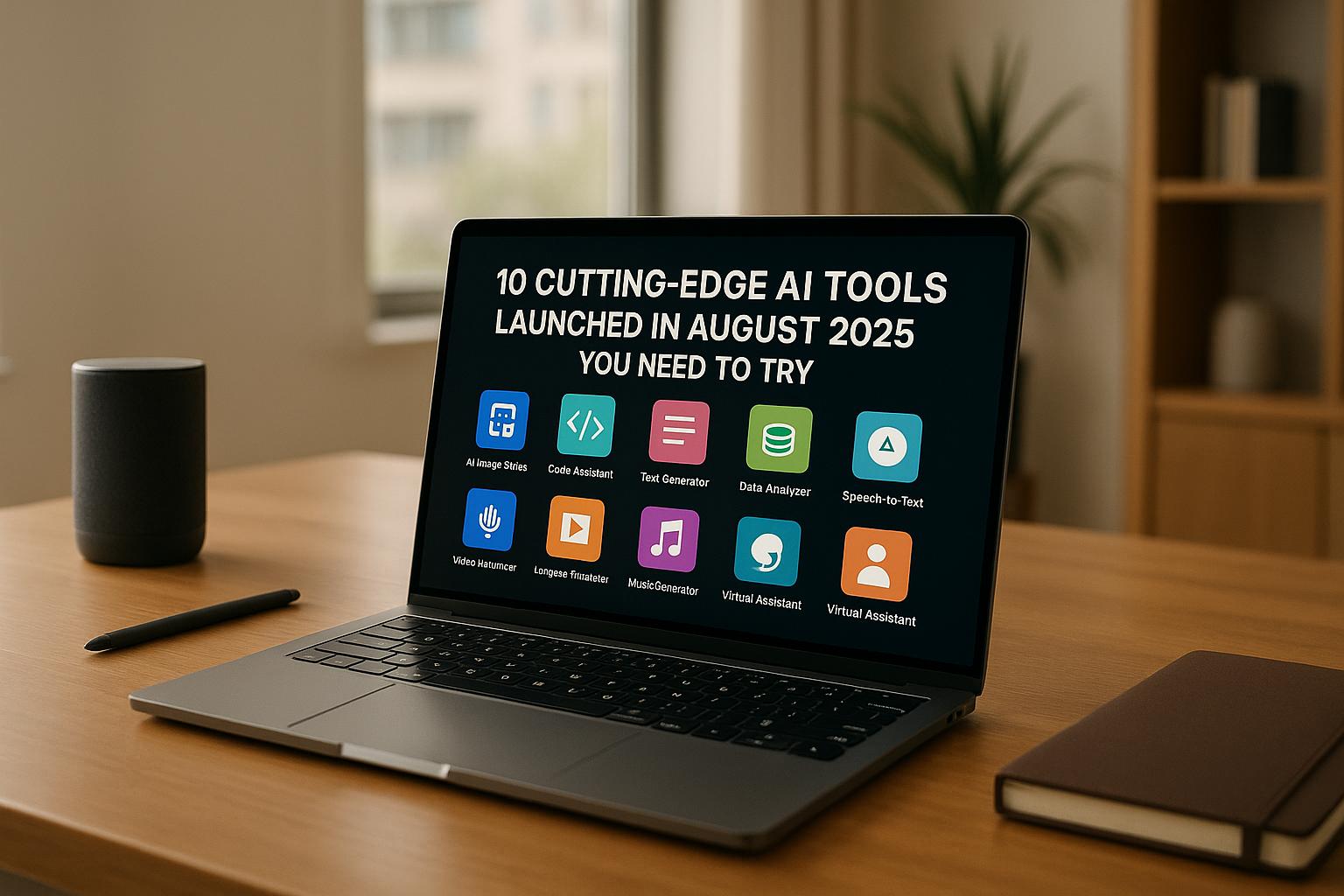No-code AI tools are transforming how businesses and individuals create AI-powered applications. You no longer need programming knowledge to build tools like chatbots, image recognition systems, or workflow automation solutions. With drag-and-drop interfaces and pre-built models, these platforms simplify AI development, reducing costs and development time.
Key Takeaways:
- What is No-Code AI? Platforms like Google AutoML, Teachable Machine, and Bubble allow users to create AI applications without writing code.
- Why It Matters: No-code AI is faster and more cost-effective than traditional methods, enabling small businesses and non-technical users to compete in AI-driven markets.
- Common Applications: Automating tasks, data analysis, and building customer-facing solutions in industries like banking, healthcare, and retail.
- Top Platforms:
- Google AutoML/Vertex AI: Comprehensive AI development, from data prep to deployment.
- Teachable Machine: Beginner-friendly for tasks like image and sound classification.
- Bubble: Full app development with integrated AI features.
- Challenges: Limited customization, scalability concerns, and potential vendor lock-in.
US-Specific Insights:
- Regulations: U.S. businesses must comply with frameworks like NIST AI Risk Management and industry-specific standards.
- Security Needs: Look for encryption, access controls, and compliance certifications when selecting platforms.
By 2025, 70% of enterprise apps are expected to use no-code or low-code technologies, making these tools essential for staying competitive. Whether you're a small business owner, educator, or entrepreneur, no-code AI platforms can help you build powerful tools quickly and affordably.
How to Build Your Own App with AI for free
Top No-Code AI Platforms
The rise of no-code AI platforms has made machine learning more accessible than ever, breaking down technical barriers and opening doors for individuals and businesses alike. Let’s dive into some of the standout platforms shaping this space.
Google AutoML and Vertex AI
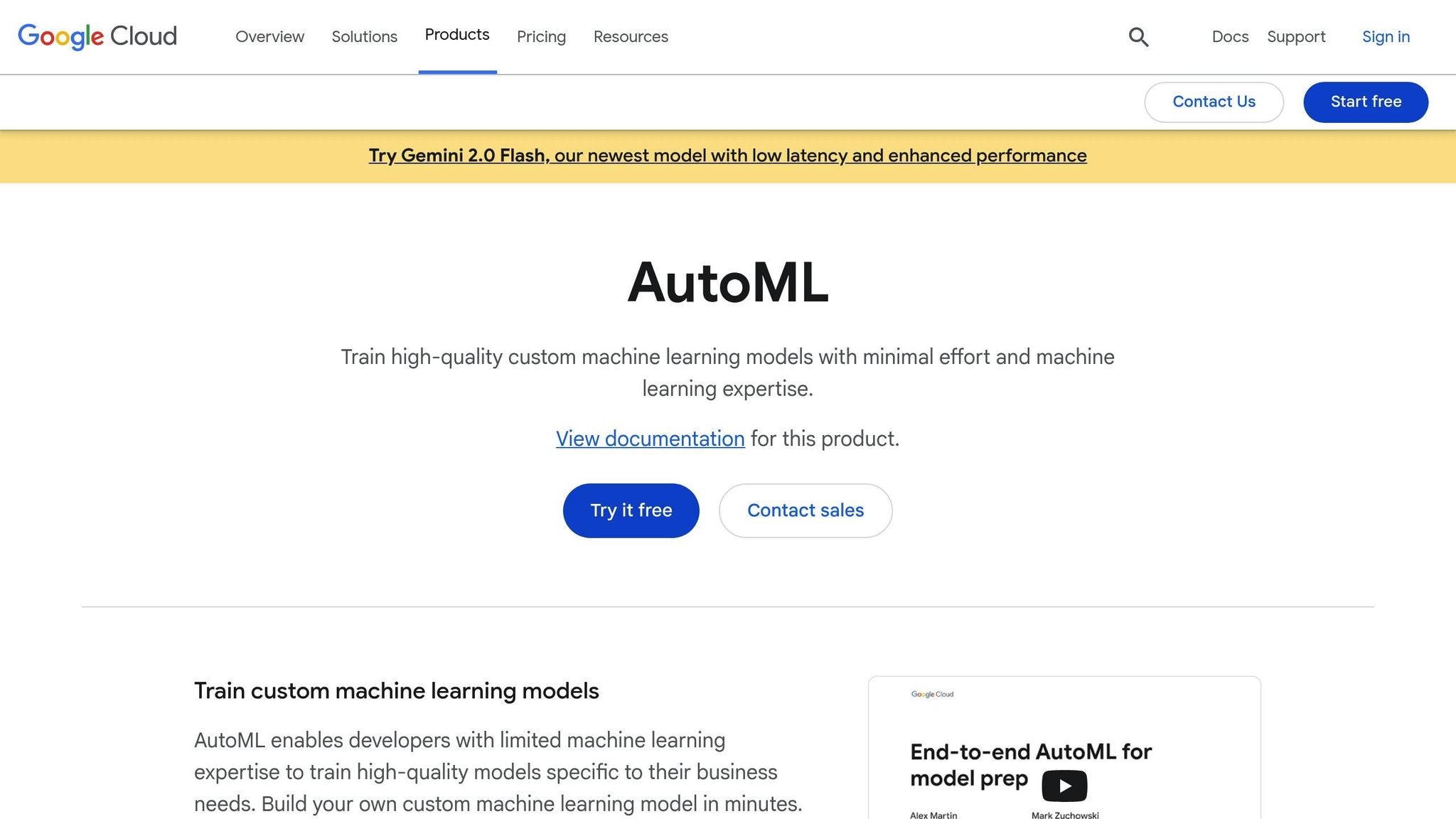
Google's Vertex AI is a robust platform designed to simplify the entire AI development process. It brings together everything from data preparation to model deployment, making it a one-stop solution for businesses. Key features include AutoML, Model Garden, and Agent Builder, which enable users to build, train, and deploy AI models without needing advanced technical expertise.
- AutoML: This feature allows users to train high-quality models on their datasets without writing a single line of code. It’s perfect for teams with limited AI experience.
- Model Garden: Offers access to pre-trained models, including Google's own foundation models.
- Agent Builder: Helps set up AI agents for handling complex tasks.
A great example of Vertex AI in action is Kraft Heinz. In June 2025, the company used Google's generative models, Imagen and Veo, through Vertex AI to overhaul their marketing process. They managed to cut their campaign creation time from eight weeks to just eight hours.
"Vertex AI streamlines machine learning for organizations by unifying the entire workflow on a single, accessible platform. It brings together everyone from data scientists to business analysts, making collaboration and production deployment much simpler." - cloudchipr.com
Vertex AI operates on a pay-as-you-go pricing model, making it an affordable option for businesses of all sizes. To save on costs, users are advised to undeploy models when they’re not in use.
Teachable Machine
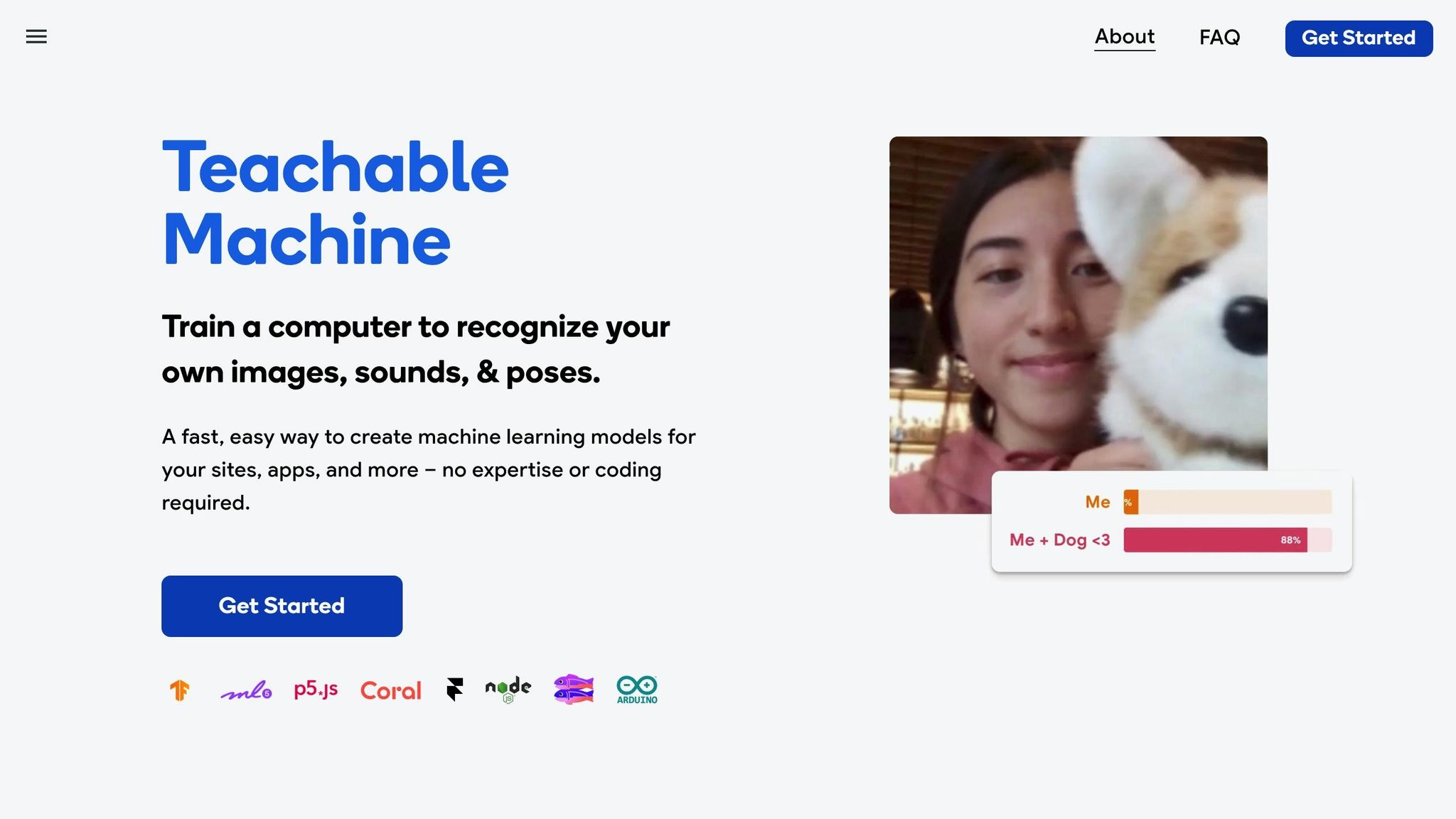
For those new to AI, Teachable Machine offers a simple, user-friendly entry point. This free, web-based tool from Google lets anyone create and train machine learning models in just minutes using a drag-and-drop interface. It’s an ideal choice for educators, hobbyists, and small businesses looking to experiment with AI.
The platform focuses on three main areas:
- Image recognition
- Sound classification
- Pose detection
Users can train their models by uploading images, recording sounds, or demonstrating poses via webcam. Once trained, the models can be easily exported for use in websites, apps, or hardware devices.
Teachable Machine has inspired creative applications. For instance, Steve Saling used it to communicate through facial gestures that trigger sounds, while Vince MingPu Shao built a game controller using just a webcam and paper. Its browser-based design eliminates the need for complex setups, making it accessible to non-technical users.
Bubble
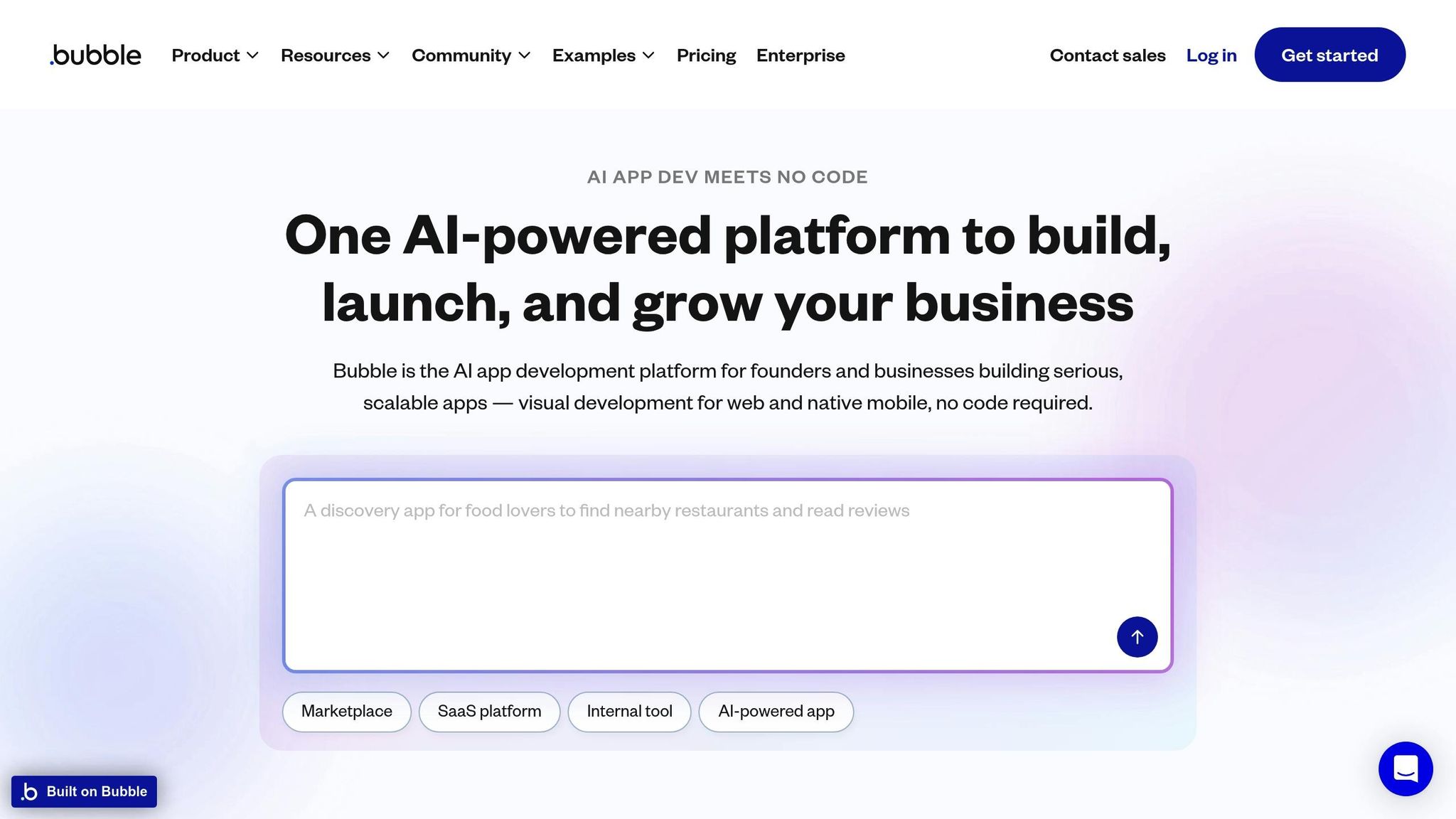
Bubble takes no-code development to the next level by allowing users to build fully functional web and mobile apps - complete with AI features - using a drag-and-drop interface. From designing user interfaces to managing databases and workflows, Bubble provides a comprehensive ecosystem for app development.
Key highlights include:
- API Connector and Plugins: Easily integrate AI features like chatbots, natural language processing, and computer vision.
- Automatic Scaling and Deployment: Focus on building your app while Bubble handles the backend.
The platform’s impact is evident in real-world success stories. Unity used Bubble to create a customer support tool that reduced ticket resolution time by 40% and boosted team productivity by 35% in just three weeks. Meanwhile, Seagate developed an inventory management system that cut development costs by 65% and improved supply chain efficiency by 28%.
"Bubble is the best no-code platform, and it has the most capability of any platform I've ever tried. Trust me, I've tried all of them. It's really a game changer. If you're going to go no-code, start with Bubble. You won't regret it." - Michael Ong, Product Manager at Seagate
With over 3 million apps built on the platform, Bubble has proven its scalability. Its pricing starts with a free plan for prototyping and scales up to $29/month for the Starter Plan, $119/month for Growth, and $349/month for Team plans. Additionally, Bubble supports mobile app development using React Native, enabling developers to target both iOS and Android from a single codebase. This all-in-one approach makes it a go-to choice for US businesses looking to build AI-powered tools without coding expertise.
How to Build AI Tools Without Coding
Creating your own AI tool involves three main steps: picking the right platform, preparing your data, and setting up your tool for launch.
Picking the Right Platform
The first step is to choose a no-code AI platform that aligns with your project goals. Start by identifying the specific problem your AI tool will solve - whether it’s automating customer support, analyzing sales trends, or recognizing images.
When evaluating platforms, focus on ease of use, flexibility, and the strength of the AI capabilities they offer. Look for features like drag-and-drop interfaces, detailed documentation, and scalability. For example:
- Google's Vertex AI: Great for robust machine learning projects.
- Teachable Machine: Perfect for simpler tasks like classifying images or sounds.
- Bubble: Ideal for building full web applications with integrated AI.
It’s also important to consider your technical expertise. If you’re a beginner, platforms like Teachable Machine provide straightforward, web-based training. For more advanced needs, opt for tools that handle complex workflows.
Once you’ve selected your platform, you’re ready to prepare your data for training your AI model.
Getting Your Data Ready
The quality of your data is critical to the success of your AI tool. Start by gathering relevant and reliable data from your sources, prioritizing quality over sheer volume.
For projects in the U.S., ensure your data follows standard formats. Use MM/DD/YYYY for dates, commas as thousand separators (e.g., 1,000.50), and include the dollar sign ($) for currency values. When working with CSV files, stick to commas as delimiters and periods for decimals.
Next, clean your data to remove errors and inconsistencies. This involves:
- Eliminating duplicate entries.
- Filling in missing values with reasonable estimates or removing incomplete records, depending on their significance.
- Correcting inconsistencies in formatting or data patterns.
Normalization and standardization are also crucial. These processes ensure all data points are on a similar scale, which helps the AI model perform more effectively. For instance, if your dataset includes both dollar amounts and quantities, scale them so neither overshadows the other during training.
Finally, split your dataset into training, validation, and testing sets. A common split is 70% for training, 15% for validation, and 15% for testing, though you can adjust this based on your project’s requirements.
Once your data is clean and ready, you can move on to setting up and launching your AI tool.
Setting Up and Launching Your AI Tool
Begin by using a testing environment to experiment and refine your tool before deploying it in a live setting.
Pre-trained models can save you time for tasks like text analysis, image recognition, or predictive analytics. These models can be customized with your own data to fit your specific needs.
Testing and fine-tuning are essential to ensure accuracy. Use your validation dataset to evaluate the model’s performance, identifying strengths and areas where adjustments are needed. Most no-code platforms offer visual dashboards with metrics that make it easier to pinpoint issues.
Once testing results are satisfactory, deploy your AI tool. Start with a small-scale rollout - such as a limited group of users or a specific use case - to identify and resolve any real-world issues before a full launch.
AI tools often lead to measurable improvements in areas like customer support and marketing efficiency. To maintain and enhance performance, schedule regular reviews to refine your models based on new data and user feedback.
Lastly, stay updated on platform updates and insights from user communities to keep your AI tool performing at its best.
sbb-itb-212c9ea
Pros and Cons of No-Code AI Platforms
No-code AI platforms are changing the game by removing technical hurdles, making development more accessible for businesses and individuals alike. Understanding their strengths and weaknesses is key to deciding when these tools are the right fit versus when traditional development methods might be a better option. While these platforms bring numerous benefits, they also come with challenges that shouldn't be overlooked.
Benefits of No-Code AI
One of the standout benefits of no-code AI platforms is how they open up AI development to non-technical users. By eliminating the need to write code, these tools have created new opportunities, with the no-code market projected to hit $52 billion by 2024.
Another major perk is cost savings. Since no-code platforms simplify development, businesses can reduce expenses by avoiding the need for large, specialized teams.
Speed is another big draw. With no-code tools, users can create solutions up to 10 times faster than with traditional development methods. This speed translates to quicker product launches, lower costs, and an environment that encourages innovation. For example, organizations using AI tools report they’ve cut repetitive tasks by up to 30%, and a Harvard Business School study noted productivity gains of 17–43% for developers using AI.
"No-code tools let you make powerful software using simple drag-and-drop interfaces, saving time and money." - AI Institute
No-code AI also empowers non-technical employees to take charge of building apps, automating workflows, creating dashboards, or designing forms - without waiting on IT teams.
Drawbacks of No-Code AI
Despite their advantages, no-code platforms aren't without their flaws. They often come with limitations that can impact long-term success. Common challenges include restrictions on customization, scalability concerns, and hidden costs that may arise as projects grow.
| Limitation | Description | Impact on Projects |
|---|---|---|
| Customization Limits | Predefined templates can hinder creativity and may not support niche needs | Hard to meet specific business goals or stand out in the market |
| Scalability Issues | High traffic or large-scale apps may face performance bottlenecks | Systems may slow down under heavy usage, limiting growth |
| Integration Restrictions | Limited API access and reliance on proprietary ecosystems | Makes it harder to connect with existing tools |
| Performance Concerns | Abstraction layers can reduce speed and optimization | Slower user experiences, risking customer dissatisfaction |
| Security Limitations | Limited control over security measures and potential data risks | Could lead to compliance issues or data breaches |
| Vendor Lock-In | Transitioning to a different platform can be difficult | Limits flexibility and may increase costs over time |
Another challenge is the learning curve. While marketed as beginner-friendly, mastering the more advanced features of no-code platforms can take time, especially for complex projects. This can lead to underestimating the effort required to fully utilize these tools.
For U.S.-based projects, additional regulatory and security requirements add another layer of complexity.
US-Specific Requirements
In the U.S., businesses must navigate a patchwork of regulatory and security standards. Unlike the European Union's GDPR, the U.S. doesn’t have a single, unified framework for handling personal data used in AI. Instead, companies rely on voluntary guidelines like the NIST AI Risk Management Framework and the Blueprint for an AI Bill of Rights.
Security is a top priority for U.S. businesses. Most no-code AI platforms address this through encryption, secure data transmission, authentication, and access control. Many platforms also comply with global standards like GDPR, HIPAA, or SOC 2. When evaluating a platform, look for features like robust encryption, role-based access control, and relevant compliance certifications.
The concept of "Security by Design" is especially crucial in U.S. deployments. Modern no-code platforms bake security into every stage of development. This approach helps reduce risks like data breaches or unauthorized access.
"Secure by Design means that manufacturers of AI systems must consider the security of the customers as a core business requirement, not just a technical feature, and prioritize security throughout the whole lifecycle of the product, from inception of the idea to planning for the system's end-of-life." - Christine Lai, AI Security Lead, and Dr. Jonathan Spring, Senior Technical Advisor, CISA
It’s also essential to ensure the platform aligns with your industry’s specific regulatory needs. Balancing innovation with privacy protection is critical. Businesses must stay on top of regulatory changes while enforcing strong data governance practices. Features like data privacy controls, accountability measures, and robust protection mechanisms are non-negotiable when choosing a no-code AI platform.
Find and Compare AI Tools with AI Apps
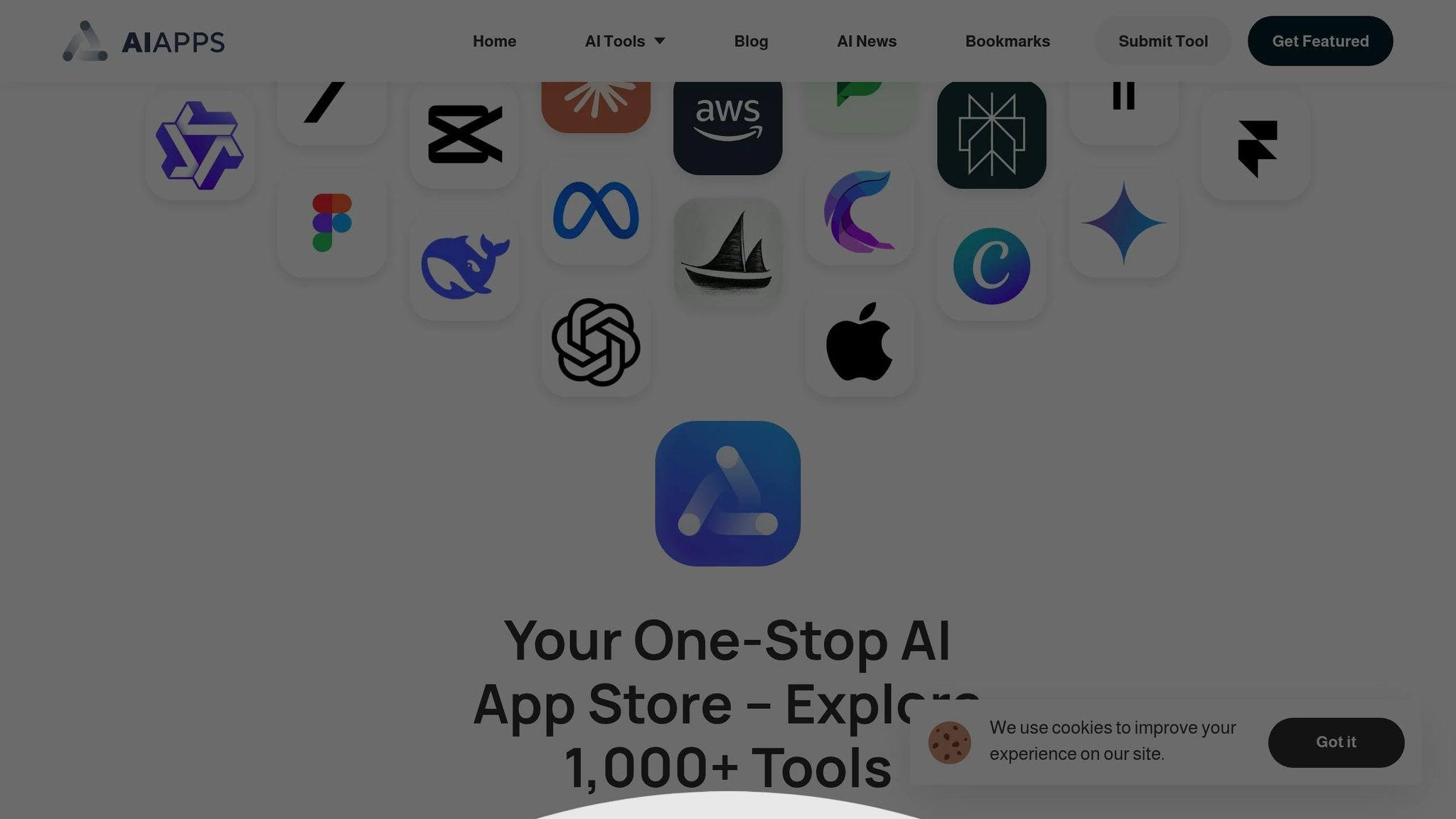
With the growing demand for no-code AI solutions in the U.S., finding the right tools for specific business needs has never been more important. A 2024 survey revealed that 72% of companies now use AI in at least one business function. This surge in adoption calls for a reliable way to discover and evaluate AI tools. That’s where AI Apps steps in as a key resource.
What is AI Apps?
AI Apps serves as a one-stop platform for discovering and comparing AI tools. It boasts a curated directory of over 1,000 AI applications spanning various categories. By simplifying access to artificial intelligence, the platform helps U.S. businesses deploy AI and machine learning models without requiring coding expertise. This approach eliminates traditional technical hurdles, making it easier for companies - especially small businesses - to integrate AI into their operations quickly and effectively.
The platform organizes tools into detailed categories like AI Art Generators, AI Text Generators, AI Video Tools, and automation solutions. Each listing undergoes a thorough verification process to ensure it meets quality and relevance standards. This structured approach ensures businesses can confidently adopt tools that align with their goals, even without technical expertise.
AI Apps Features
AI Apps offers a range of features designed to make the search for AI tools straightforward:
- Advanced Filtering and Search: Users can refine their search by category, sub-category, or pricing model, helping them pinpoint the most suitable tools.
- Transparent Pricing: All prices are displayed in USD, making it easy for U.S.-based businesses to compare costs.
- Featured and New Tools: The platform highlights noteworthy and recently launched tools, keeping users informed about the latest advancements in no-code AI.
- Developer Submissions with Quality Controls: Every tool submitted by developers undergoes a strict review process, ensuring reliability and relevance. This is especially beneficial for businesses looking to avoid the complexities of traditional AI processes, which often require specialized machine-learning expertise. No-code AI eliminates about 90% of these challenges, making it a game-changer for business users.
These features save users time and effort, allowing them to focus on integrating AI tools that directly benefit their operations.
Benefits for U.S. Users
For businesses and individuals in the U.S., AI Apps addresses specific market needs. By removing coding barriers, the platform empowers users to create and deploy AI models with ease. A December 2023 survey by the General Accounting Office identified over 1,200 potential applications for AI within federal government departments. This regulatory push underscores the importance of accessible and compliant AI tools. Assistant Attorney General Nicole Argentieri emphasized this shift, stating:
"Just as we are upping our game when it comes to data analytics, we expect companies to do the same."
AI Apps provides a vetted selection of tools that align with these evolving standards. Its focus on speed and cost-effectiveness is particularly valuable for small and medium-sized businesses. By offering low upfront costs and intuitive drag-and-drop interfaces, the platform reduces adoption barriers, enabling quicker decision-making and fostering innovation without the need for expensive data science teams.
For entrepreneurs and professionals, AI Apps simplifies testing, integration, and iterative improvements, making it easier to innovate and adapt without heavy technical investments. Whether you're a startup or an established business, AI Apps offers a streamlined way to leverage AI for growth and efficiency.
Conclusion
No-code AI platforms are reshaping AI development by eliminating the need for programming expertise, making advanced AI tools more accessible for a wide range of business applications. What once required months of effort from specialized teams can now be achieved in a fraction of the time, marking a major shift in how AI solutions are created and deployed in the U.S. market.
Projections indicate that by 2025, 70% of new enterprise applications will rely on low-code or no-code technologies, while 89% of small businesses have already embraced AI tools. These trends highlight the appeal of faster implementation, lower costs, and greater flexibility.
For users in the U.S., platforms like Google AutoML, Teachable Machine, and Bubble offer user-friendly tools to build custom AI applications. Whether it's automating customer service, analyzing sales data, or designing image recognition systems, these platforms provide drag-and-drop interfaces and ready-made templates, enabling businesses to turn ideas into functional solutions quickly and affordably.
This growing accessibility strengthens the broader AI ecosystem. Tools like AI Apps simplify the search for AI solutions with a curated directory of over 1,000 tools, advanced search options, and transparent pricing in USD - helping businesses make informed, cost-effective decisions with ease.
As the AI industry heads toward a projected $500 billion valuation by 2027, no-code platforms will play a critical role in driving scalable growth. Companies that adopt these solutions early will be well-positioned to lead the next wave of innovation.
FAQs
What are the main differences between Google AutoML, Teachable Machine, and Bubble for building AI tools without coding?
The main differences between Google AutoML, Teachable Machine, and Bubble come down to their focus, complexity, and intended use.
- Google AutoML is tailored for building advanced, scalable AI models. While it doesn’t demand coding skills, it’s better suited for users who have some familiarity with machine learning concepts. This makes it a strong choice for production-level AI solutions.
- Teachable Machine prioritizes simplicity, making it an excellent option for beginners or quick, straightforward projects. Its user-friendly interface allows anyone to train models easily, making it particularly useful for educational purposes or creating rapid prototypes.
- Bubble is all about creating complete web applications with integrated AI features. As a no-code platform, it’s a great tool for users who want to go beyond just training models and develop fully functional applications.
To sum it up: go with AutoML for scalable AI models, Teachable Machine for quick and easy projects, and Bubble if you’re building full-scale applications with AI capabilities.
How can businesses in the U.S. stay compliant with regulations when using no-code AI tools?
To navigate U.S. regulations while using no-code AI tools, businesses should prioritize staying informed and proactive monitoring. AI-powered compliance tools can be a game-changer here, automating tasks like risk assessments, document organization, and keeping tabs on regulatory updates. These tools can catch potential compliance issues early, helping to protect your data and operations.
Equally important is keeping up with changes in laws and guidelines. Many no-code AI platforms include features that highlight regulatory updates, ensuring your processes stay legally sound. Regularly reviewing your AI-driven workflows and consulting legal professionals can add an extra layer of security, reducing risks and keeping your business on the right track.
What challenges might arise when using no-code AI platforms, and how can they be addressed?
No-code AI platforms come with their share of challenges. These include limited customization, potential scalability problems, and performance limitations when handling complex tasks. Additionally, concerns like vendor lock-in, security vulnerabilities, and restricted integration options with other tools or systems can arise.
To navigate these issues, focus on selecting platforms that provide enough flexibility and scalability to adapt as your needs evolve. Look for tools with robust security features, and take the time to fully understand the platform's constraints before diving into development. Careful planning and thorough testing can go a long way in reducing risks and ensuring your AI solution works as intended.
